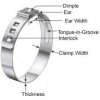I searched around on the forum and didn't really find an answer in previous threads.
Does anyone have any tips for easily removing the compression ring style hose clamps fitted to the stock fuel injection lines?
I spent about 2 hours cutting away at one of the hoses in order to remove the ring intact.
The next few rings I cut off with a Dremel, but it is very difficult to not nick the anything other than the ring. I still have 6 rings to remove - there has to be an easier way to get these off.
Hi, Tyler,
On the hi-pressure side of the FI system, the original fuel injection hose installation from the factory was accomplished with the correct 7.5mm FI hose pushed onto very sharp-edged hose barbs. The fabric weave inside the hose provides much of the "grip strength" the hose exerts on the barb to create and maintain a leak-free pressure seal. The collars that rest between the shoulder of the hose barb and the end of the hose itself are not clamps per se. They function as a positive stop for pushing the hose onto the barb to ensure the pre-cut length of hose is correctly positioned on the barb, neither pushed too far or not far enough; and they function to "contain" the cut end of the hose.
After some trial and error, here is what worked well for me. Assumption: all of the pieces you are working on are removed from the car and are on a suitable workbench type surface.
Using good quality diagonal wire cutters, cut the hose completely thru.
A. On the longer hose from the hard line to the fuel rail, cut about 1" downstream (direction of fuel flow) from the hard line fitting, and then cut about 1" upstream from where the hose fits to the left side of the fuel rail.
B. On the hoses that go from the fuel rail to the injectors, make one cut about halfway.
C. On the hose that joins the two halves of the fuel rail, make one cut in the middle.
Go to the hardware store and buy a #2 Xacto knife and a 5-pack of the super-pointy, super sharp Z-series blades, either the #2 or #11. Don't handicap yourself by trying to use razor blades, box cutters, or any thing similar. Like a surgeon, you need the right tool and blade for the job

Next, let's take an injector as an example and start surgery.
From the cut you made with the diagonal cutter above, with the Xacto knife, make an incision along and with the length of the hose, from the cut edge to the point where the blade contacts the collar, to a depth of about 1/3 the thickness of the hose. You should have sliced deep enough to have gone thru the top rubber layer and exposed the fabric weave. Repeat the incision, cutting into and just deeper than the fabric weave. Repeat the incision once more, slicing thru the full depth of the hose, UNTIL you get to the tip of the injector barb. Ease up on the pressure and go for a depth of about halfway into the inner rubber of the hose. You absolutely, positively DO NOT want to contact the injector barb, or any other barb, with the Xacto knife blade.
Next, get a good pair of pliers preferably with rubberized grip handles. At the cut end of the hose, spread the hose at the cut and grip the hose with the pliers so that one grip surface of the pliers is on the inner surface of the hose and the other grip surface of the pliers is on the outer surface of the hose. Now position the pliers, hose and injector in your hands like you were trying to snap a twig (see linked video) and "peel back" the hose off of the injector. The force of your hands will peel the rest of the hose off of the injector and now the collar will be free to drop off.



